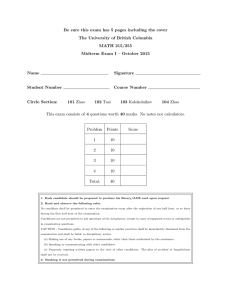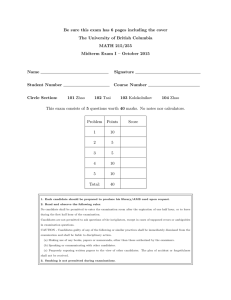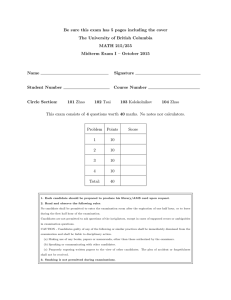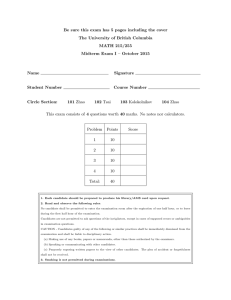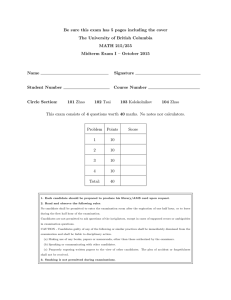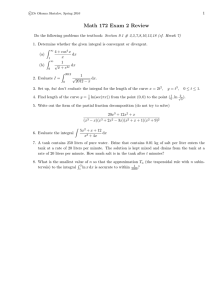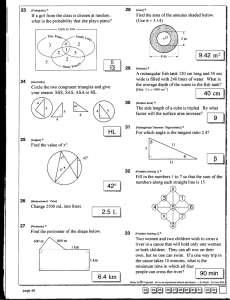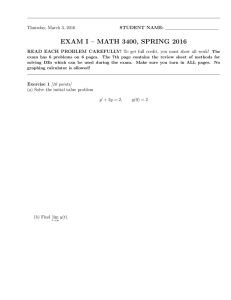Be sure this exam has 6 pages including the cover
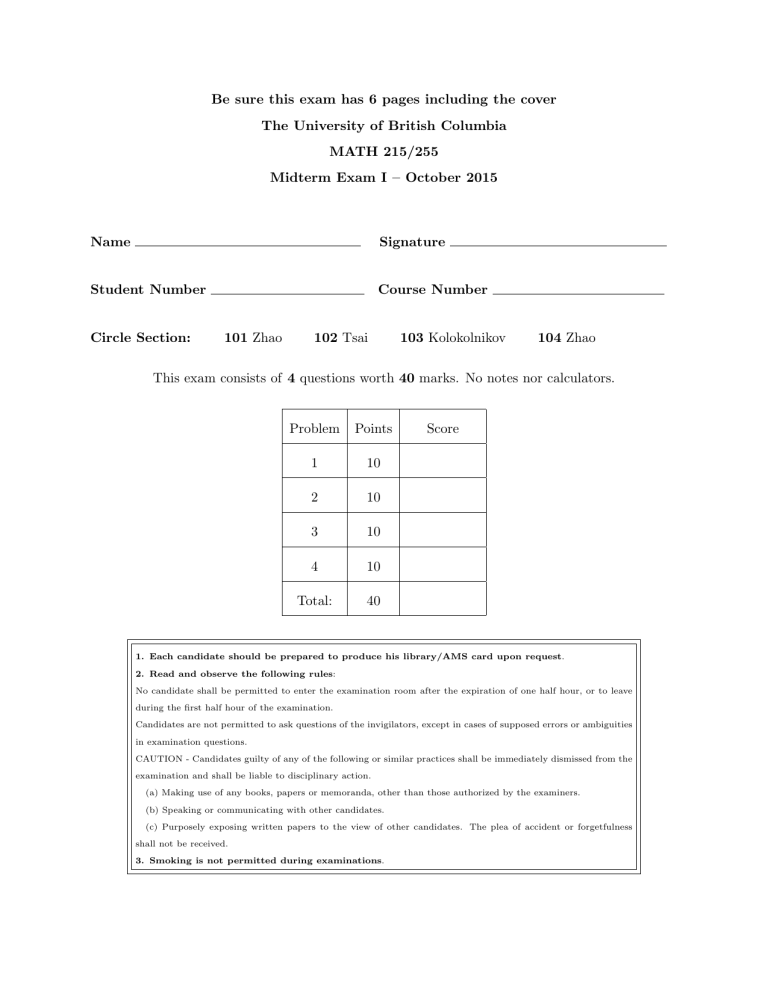
Be sure this exam has 6 pages including the cover
The University of British Columbia
MATH 215/255
Midterm Exam I – October 2015
Name Signature
Student Number Course Number
Circle Section: 101 Zhao 102 Tsai 103 Kolokolnikov 104 Zhao
This exam consists of 4 questions worth 40 marks. No notes nor calculators.
Problem Points
3
4
1
2
Total: 40
10
10
10
10
Score
1. Each candidate should be prepared to produce his library/AMS card upon request .
2. Read and observe the following rules :
No candidate shall be permitted to enter the examination room after the expiration of one half hour, or to leave during the first half hour of the examination.
Candidates are not permitted to ask questions of the invigilators, except in cases of supposed errors or ambiguities in examination questions.
CAUTION - Candidates guilty of any of the following or similar practices shall be immediately dismissed from the examination and shall be liable to disciplinary action.
(a) Making use of any books, papers or memoranda, other than those authorized by the examiners.
(b) Speaking or communicating with other candidates.
(c) Purposely exposing written papers to the view of other candidates. The plea of accident or forgetfulness shall not be received.
3. Smoking is not permitted during examinations .
October 2015 Math 215/255 Midterm 1 Page 2 of 6
(6 points)
1. Consider the following initial value problem:
( y
0
= xy − y, y (2) = 2 .
(1)
(a) Find the explicit solution to the problem (1).
Answer .
It’s easy to see that y
0
= y ( x − 1), that is, dy dx
= y ( x − 1). Since y (2) = 2, then y ( x ) > 0 for all x . So we get
1 y dy = ( x − 1) dx.
Then
Z 1 y dy =
Z
( x − 1) dx , that is, ln y = x
2
2
− x + C . Since y (2) = 2, then ln 2 = 2 − 2 + C , that is, C = ln 2. So we get ln y = x
2
2
− x + ln 2, which implies that y = e x
2
2
− x +ln 2
= 2 e x
2
2
− x
.
(4 points) (b) Use Euler’s method to approximate y (4) to the problem (1) with the step size 1.
Answer .
Recall the linear approximation, we get y ( x + ∆ x ) ≈ y ( x ) + y
0
( x )∆ x = y ( x ) + ( xy − y )∆ x.
Let y k
= y ( x k
), put x = x k and ∆ x = 1 in the above formula, so we have y k +1
= y k
+ ( x k y k
− y k
) · 1 = x k y k
.
Then we have k x k y
0 2 2 k
1 3 y
1
2 4 y
2
= x
0 y
0
= x
1 y
1
= 2 · 2 = 4
= 3 · 4 = 12
October 2015 Math 215/255 Midterm 1 Page 3 of 6
(2 points)
2. A solution that contains 5 grams/liter of salt is being poured into a tank at a rate of 1 liters/minute. At the same time, the solution in the tank flows out at a rate of 2 liters per minute. Initially, the tank contains 50 liters of pure water. Let y ( t ) be the amount in grams of salt in the tank at time t minutes, then y ( t ) satisfies y
0
+
2
50 − t y = 5 , y (0) = 0 .
(a) How long will it take for the tank to be empty?
Answer .
It’s easy to know that the remaining volume of the solution in the tank at time t is 50 − t , so after 50 minutes, the tank will be empty.
(8 points) (b) How much salt will there be in the tank when 20 liters remain?
Answer .
Multiply r ( t ) on the both sides of y
0
+
2
50 − t y = 5, then r ( t ) y
0
+
2
50 − t r ( t ) y = 5 r ( t ) .
We are looking for an integrating factor r ( t ), then r ( t ) y
0
+
2
50 − t r ( t ) y = [ r ( t ) y ]
0
= r ( t ) y
0
+ r
0
( t ) y.
So we get
2
50 − t r ( t ) = r
0
( t ), that is, r
0
=
2
50 − t r , which implies that r ( t ) = e
R 2
50 − t dt
= e
− 2 ln(50 − t )
= (50 − t )
− 2
.
So we get
[(50 − t )
− 2 y ]
0
= 5(50 − t )
− 2
.
Hence (50 − t )
− 2 y = 5
Z
(50 − t )
− 2 dt = 5(50 − t )
− 1
+ C . So y ( t ) = 5(50 − t ) + C (50 − t )
2
.
Since y (0) = 0, then 0 = 5 · 50 + C · 50
2
1
, that is, C = −
10
. Therefore, we get y ( t ) = 5(50 − t ) −
1
10
(50 − t )
2
.
Since the reining volume in the tank at time t is 50 − t , so after 30 minutes, there will be
20 liters in the tank. So we get y (30) = 5 · (50 − 30) −
1
10
(50 − 30)
2
= 60 .
October 2015 Math 215/255 Midterm 1 Page 4 of 6
(4 points)
3. Let k be a real constant, consider the following differential equation:
(2 x
2
+ ky ) + ( x
2 y − x ) y
0
= 0 , for x > 0 .
(a) Find the value of k such that r ( x ) =
1 x 2 is an integrating factor for the equation (2).
Answer .
Multiply r ( x ) =
1 x 2 on the both sides of (2), then
2 + ky x 2
1
+ y − x y
0
= 0 .
(2)
Since r ( x ) =
1 x 2 is an integrating factor for (2), then we have
∂
∂y
2 + ky x 2
∂
=
∂x
1 y − x
.
Hence we get k x 2
=
1 x 2
, which implies that k = 1 .
(6 points) (b) When k takes the value found in the previous part, find the solution to the problem (2) with the initial value condition y (1) = 2. (You can keep the implicit form of the solution)
Answer .
By the result of part (a), we know that k = 1 and y
2 + x 2
+ y −
1 x y
0
= 0 is exact, which implies that there exists some function φ ( x, y ) such that y 1
• φ x
( x, y ) = 2 + and φ y
( x, y ) = y − .
x 2 x
• the solutions to the differential equation is given by φ ( x, y ) = C .
October 2015 Math 215/255 Midterm 1
Since φ x
( x, y ) = 2 + y x 2
, then
φ ( x, y ) =
Z
2 + y x 2 dx + f ( y ) = 2 x − y x
+ f ( y ) .
Take the partial derivative with respect to y , then
φ y
1
( x, y ) = − x
+ f
0
( y ) .
Since φ y
( x, y ) = y −
1 x
, then y −
1 x
1
= − x
+ f
0
( y ) .
That is, f
0
( y ) = y , which implies that we can take f ( y ) = y 2
. So we get
2
φ ( x, y ) = 2 x − y x
+ y
2
2
= C.
Since y (1) = 2, then 2 − 2 + 2 = C , that is, C = 2. So the solution is:
2 x − y x
+ y 2
2
= 2 .
Page 5 of 6
October 2015 Math 215/255 Midterm 1 Page 6 of 6
(7 points) 4. (a) Consider the following autonomous differential equation: y
0
= y ( y − 1)
2
( y + 2) .
Draw the phase diagram of the problem (3), and classify the critical points of the problem (3) stable or unstable.
Answer .
It’s easy to see that y = 0, y = 1 and y = − 2 are all critical points for (3).
(3)
(3 points)
So we know that y = 1 is unstable(node), y = 0 is unstable(source), and y = 2 is stable(sink).
(b) It’s easy to verify that y
1
( x ) = x and y
2
( x ) = x + 2 e
− x
2 differential equation y
0
= 1 + 2 x
2 − 2 xy . Let g ( x are two solutions to the
) be the solution to the initial value problem:
( y
0
= 1 + 2 x
2
− 2 xy, y (0) = 1 .
(4)
Find the limit lim x →∞ g ( x ) x and explain why. (Hint: Existence and uniqueness theorem)
Answer .
Let f ( x, y ) = 1 + 2 x
2 − 2 xy , then f y
( x, y ) = − 2 x . Both f ( x, y ) and f y
( x, y ) are polynomials and hence are continuous for all x and y , so we can apply the existence and uniqueness theorem for all initial values. In particular, solutions do not cross each other.
Since y
1
(0) = 0, g (0) = 1 and y
2
(0) = 2, by the uniqueness theorem, we know that y
1
( x ) < g ( x ) < y
2
( x ) , for all x ∈
R
.
That is, we get x < g ( x ) < x + 2 e
− x
2
, for all x ∈
R
.
So we get
Therefore, we know that
1 < g ( x ) x
< 1 +
2 e
− x
2
, for all x > 0 .
x lim x →∞ g ( x )
= 1 .
x
